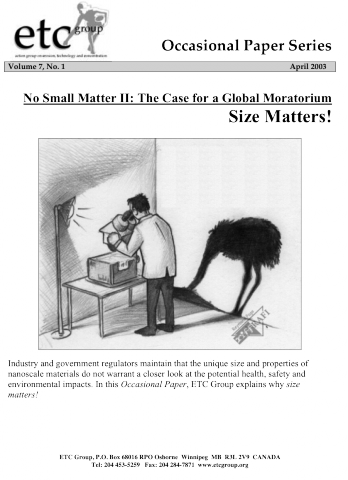Submitted by ETC Staff on
Industry and government regulators maintain that the unique size and properties of nanoscale materials do not warrant a closer look at the potential health, safety and environmental impacts. In this Occasional Paper, ETC Group explains why size matters!
Issue: Decades after their appearance in laboratories and in consumer products, some scientists are beginning to wonder if the nanoscale particles so valued for their chemical reactivity and other quantum characteristics should be investigated for their possibly negative impacts on our health and environment. Even though industry is pushing to scale-up the manufacture of “bulk” nanoparticles and to commercialize even less well-researched carbon nanotubes, there appear to be no government regulations in Europe or North America to ensure the safety of workers or consumers. Yet, nanoparticles already find daily use in sunscreens (including some intended for children, from infancy onwards), cosmetics, and in wound dressings, along with scores of other products and processes. Regulators do not test nano-sized materials for health, safety and environmental impacts if their macro- or micro-sized counterparts have already been approved.
Impact: The current market for nanoparticles is small, but analysts predict it will exceed $900 million by 2005. Some of the world’s largest companies (DuPont, BASF, L’Oréal, Hewlett-Packard, Mitsubishi, Toyota, and IBM) as well as some of the world’s smallest (NanoProducts, Nanophase, Altair) are ratcheting up nanomaterial research quickly. Nanoparticles represent Phase I of a new industrial revolution, which the US National Science Foundation values at $1 trillion by 2015. Atomtech (or nanotech, as the industry prefers to call it) cuts across every industrial sector and will affect every national economy. The potential impact of nanoparticles – for good or ill – on the environment and on human health is enormous. Beyond nanoparticles, impressive strides are being made in the field of nanobiotechnology. Developments that many believed to be either impossible or decades distant, such as molecular manufacturing, now appear more likely and closer at hand. If the industry can’t be trusted with the safe development of nanoparticles, it will have no credibility when it comes to atomtech’s more sophisticated applications – such as molecular self-assembly (see ETC Group Communiqué # 77, “Green Goo: Nanobiotechnology Comes Alive!”). Unless the scientific community gets behind the call for a moratorium, the future of this emerging technology could be irreparably damaged.
| Attachment | Size |
|---|---|
| 0 bytes |

